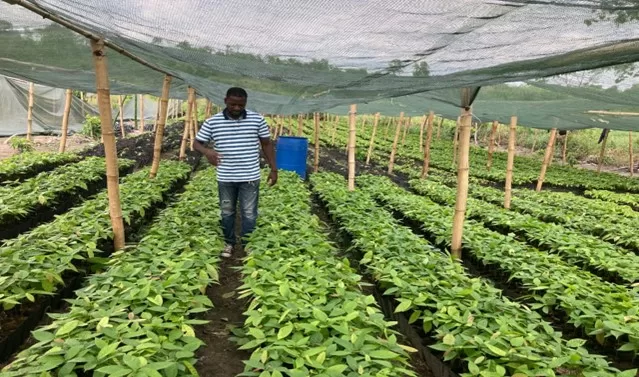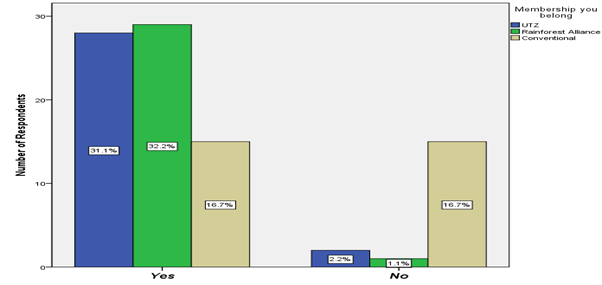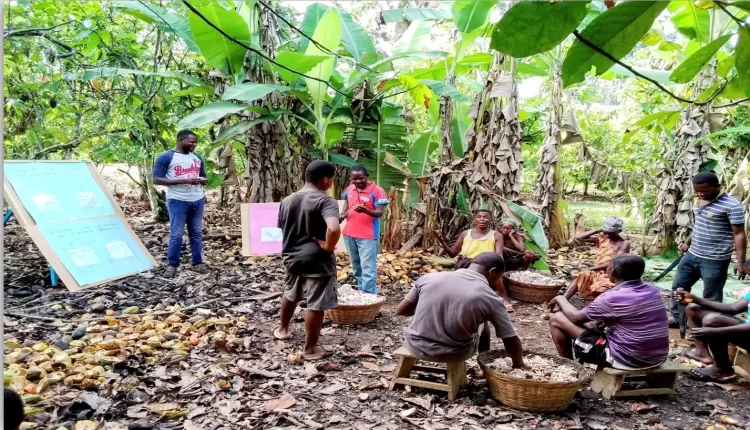What Cocoa Certification Is All About?
Cocoa certification tells the story behind the cocoa product that is being consumed and how it was cultivated under sustainable principles and therefore the producer is awarded a premium for complying with that particular credible standard. The cocoa industry in Ghana consists of small farmers producing cacao beans, Licensed Cocoa Buying Companies (LBCs) purchasing the cocoa beans, and Quality Assurance by Quality Control Company (QCC) which is a subsidiary of Ghana Cocoa Board (COCOBOD).
In theory, certification enables the consumer to differentiate between goods and services based on their good agricultural, environmental, and social attributes (ICCO, 2012). This improved information facilitates price premiums for certified products, and these premiums, in turn, create financial incentives for farmers and firms to meet certification standards. Certification systems typically evaluate and audit the processes and methods used to cultivate a product according to good agricultural, environmental, and social sustainability standards.
The mechanism also provides the platform to comply with sustainable production techniques, which was clearly outlined in the UN’s Rio Earth Summit in 1992. The summit recognized standards as a principal instrument to promote sustainability by improving the livelihoods of farmers, limiting environmental degradation practices, and offering new opportunities for product marketing.
Why Should A Cocoa Farmer Be Interested In Cacao Certification?
Cacao certification has changed the scenario whereby farmers lack motivation and are reluctant to use research and development recommendations from CRIG (Cocoa Research Institute of Ghana) techniques to improve and expand their farms which has led to lower productivity.
The study was conducted at Fawomanyo and Atobease communities Dunkwa-on-Offin in the Upper Denkyira East Municipality. Based on the sampling method 50 farmers were selected each from UTz, Rain Forest Alliance certification groups, and 50 from conventional system farmers making a total of 150 respondents.
Simple random sampling was used to select 30 farmers each from the certification groups as well as conventional farmers making a total of 90. Structured close-ended and open-ended questionnaires were administered to the 60 certified respondents and 30 conventional farmers to evaluate the adoption indicators.
The parameters that were considered under the factors influencing farmers’ adoption and willingness to adopt the improved certification farming technologies were the frequencies of farmer training, farm visits, and farmer incentives/premiums.
The study established that the certified farmers had exposure to more improved farming technologies and interventions such as farmers training on good agriculture, good social practices such as forming farmer groups and good environmental practices as in protecting their environment. Farm visits by extension officers to identify and solve problems on the farmers’ farms. Farmer incentives such as premium, protective clothing, and community development projects reflected positively in their annual cocoa yield increased by 29% for UTz, 14.5% for RA, and 10.6% for conventional farmers.
What Are The Sustainability Factors Influencing The Adoption Of Improved Farming Technologies?
The factors identified to influence the adoption of cocoa certification include farmer education, farm visit, and incentives/premiums. Many farmers in the remote part of rural communities do not have the most up-to-date information on how to grow crops sustainably, efficiently, and economically. Improving their knowledge of new techniques and technologies, in addition to providing them with any physical resources necessary for implementation, can dramatically increase the farmers’ level of productivity (Rosegrant and Cline, 2003). Continuous farmer education will increase local food availability, and farmer income and establish sustainable agricultural practices.
Farm visits are most of the common forms of personal contact between the extension officer and the farmers. This often constitutes over 50 percent of the extension activity, because they take much of the agent’s time, it is important to be clear about the purpose of such visits and to plan them carefully. A farm visit is very important because it helps the extension officer familiarise themselves with the farmer and his family, enables him to give specific advice or information to the farmer on their farm activities, permits him to explain a new recommended practice or follow up and results to date and arouse general interest among the farmers and stimulate their involvement in extension activities. (F.A.O, 2016).
Farmer incentives are given to encourage farmers for protecting the environment and biodiversity ecosystems while maintaining good farming practices. This way, farmers can increase their revenue per hectare, and eventually, comply with the forest and water-protection laws will also yield ecosystem service benefits in the farms and ensure sustainability (F.A.O, 2017). Some of these incentives include premium/cash, protective clothing for farmers, farm inputs, cutlasses, improved planting materials and community development projects.

The Relevance Of Cocoa Certification To Farmers And The Cocoa Industry
After the survey, the farmers were asked their views on the relevance of the certification programme. It was realised in Figure 4.12 that almost all the farmers in the certification programme have experienced the impact of the certification and have rated it high and wished for its continuity while only 50% of the conventional farmers showed interest in their programme continuity.

The market share and total production of certified cocoa have been considerably growing. The ICCO data on total cocoa production in 2010 suggests that the total cocoa harvest was 4.3 million tonnes. It is estimated that the total certified cocoa production for the same year was around 275,000 tonnes, meaning that the certification market share doubled from 3% in 2009 to a little more than 6% in 2010 (ICCO,2010b).
CONCLUSION
The study found that the relevance of the cocoa certification program on the adoption of improved farming technologies was significant comparing the UTZ and RA certification farmers to conventional farmers.
1) Looking at the factors influencing adoption, the study established that, the certified farmers had exposure to more improved farming technologies such as farmers training on;
a) Good agricultural, good social, and good environmental practices.
b) Farm visits by extension officers to identify and solve problems on the farmers’ farm
c) Which reflected positively in their annual yield of cocoa increasing by 29% for UTz, 14.5% for RA, and 10.6% for conventional farmers who hardly practice these improved systems of farming
d) Farmer incentives/bonuses such as premium, protective clothing and village resource projects.
2) On the farm adoption frontier, the results from the study revealed that the certified farmers had a significant change in farming activities in terms of fertilizer application, farm records keeping, pruning, pest and disease control, and use of hybrid cocoa in new farm establishment when compared to the conventional farmers.
3) Considering the impact parameters, the certified farmers were significantly on the high in biodiversity conservation by keeping enough and desirable shade trees in their farms, the yield of cacao harvested per acre, children not engaged in child labour and higher number of children going to school and proper storage of agrochemicals to prevent health risks, using the approved and recommended agrochemicals as well as disposing of containers so as not to pollute water bodies or pose risk to children and other users than the conventional farmers.
Contributing Authors: Nathaniel Mensah Sakyi and Ebenezer Owusu
Thesis Supervisor: Dr Nat Owusu Prempeh
KEYWORDS
Cocoa
Certification
Farmer Livelihoods
Adoption
REFERENCES
F.A.O ( 2016). Extension methods. farm visit. www.fao.org/docrep/t0060e/T006E07.htm
F.A.O (2017). Ecosystem services and biodiversity.
www.fao.org/ecosystem-services-biodiversity/incentives/en/
ICCO (International Cacao Organization), (ICCO 2012). Growing Cacao. Origins Of Cacao and Its Spread Around the World.
ICCO (International Cacao Organization), (2010b) ICCO Quarterly Bulletin of Cacao Statistics, Vol. 36, No. 2, Cacao year 2009/2010 ICCO (International Cacao Organization), (2010a) The World Cacao Economy, Past and Present.
SAN (Sustainable Agricultural Network), (2008) Interpretation Guidelines—Indicators for Sustainable Cacao Production in Ghana, Standards and Policy Secretariat Sustainable Agriculture Program Rainforest Alliance, October 2008.
SAN (Sustainable Agriculture Network), (2009) Sustainable Agriculture Standard for Rainforest Alliance.
Potts, J., van der Meer, J., and Daitchman, J. (2010). The states of sustainability initiatives review 2010: Sustainability and transparency. Winnipeg, Manitoba: IISD, IIED, Aid environment, UNCTAD, and ENTWINED.
Upper Denkyira East Municipal District map https://en.wikipedia.org Districts of the Central Region (Ghana) Ghana geography stubs, 23 March 2017.
UTz Certified, (2009) The core Code of Conduct for Cacao
Figures
Figure 1.0 Community Farmer Coaching
Figure 2.0 Improved varieties of cocoa seedlings for certified farmers.
Figure 3.0: Bar chart of Farmers’ remarks on the relevance of the certification programme
